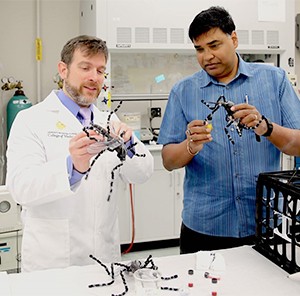The Buzz on Tracking Disease-Carrying Mosquitoes
April 7, 2016
There’s one tiny pest that bugs Americans as the temperatures heat up: mosquitoes. Besides causing itchy welts and bumps, mosquitoes can carry a multitude of diseases including West Nile virus, chikungunya, malaria, dengue fever, many types of encephalitis, and yellow fever. Additionally, with the modern convenience of international travel, diseases that are usually geographically isolated are more prone to wide-spread outbreaks, such as the most recent epidemic of the Zika virus.
Recently, the Center for Disease Control stated that the two particular mosquito species that are known to carry Zika, aedes aegypti (the yellow fever mosquito) and aedes albopictus (the Asian tiger mosquito), may be inhabiting places further north and west than just the southern region of the United States. As the spring and summer seasons progress, the Zika virus can potentially spread throughout the country, although not nearly as rapidly as it has in Latin America and the Caribbean.
The reason for the limited mosquito-borne disease outbreaks in the U.S. is that, in comparison, the developing world lacks the barriers that are standard in the developed world (e.g., air conditioners and window screens), making disease outbreaks much harder to control.
An additional burden to effective mosquito control is the currently available surveillance methods. They involve traps requiring electrical power and, in order to determine concentration levels of a particular disease, insect specimens must be sent out to a lab for analysis. Most communities in the developing world cannot sustain these requirements.
In response to the need for simpler, more manageable surveillance strategies, Bradley Willenberg, Ph.D., assistant scientist in the College of Medicine and profiled in our Faculty Feature this month, has helped to create a passive (i.e., requiring no electricity) mosquito surveillance system that virtually anyone, anywhere can use. It can be used wherever mosquito monitoring is needed, even in the more remote areas of the world.
The trap works by luring the mosquitoes with a scented mixture specifically created for the aedes aegypti and aedes albopictus species. Once inside, the mosquitoes find a wick-based device, soaked in a cocktail of red-dyed sugar water, insecticide, and gold nanoparticles—technology created by materials scientist Sudipta Seal, Ph.D. and his team.
Once the insect ingests the solution, specially formulated nanoparticles bind to the proteins of the monitored disease, causing the mosquito’s full belly to turn from red (as a result of the dyed sugar water) to blue. Thus, the greater number of dead blue mosquitoes, the greater the concentration of disease-carrying insects. For each disease, a special gold nanoparticle can be created, which involves a vast amount of research. For example, the Zika virus and dengue fever are similar in their genetic makeup so one of the research challenges is to identify the differences.
The research behind this innovation has received some notable funding support for global ventures as well as some local partnership opportunities. This mosquito surveillance project received a $100,000 Phase 1 Grand Challenges Explorations Grant from the Bill & Melinda Gates Foundation in November 2015, focusing on monitoring chikungunya. Willenberg is also working with the state of Florida to develop a sensor to detect salivary proteins in mosquitoes for further research on the insect.
—
A low-tech mosquito surveillance system that only requires the ability to see changing colors has the potential to create a healthier world and is currently being developed here at UCF. To learn more, contact Brion Berman.
Photo courtesy of UCF College of Medicine
